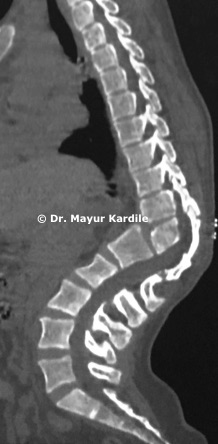 Book Appointment
Book Appointment
 +91 77740 40002
+91 77740 40002

Kyphosis is a condition which leads to forward rounding of the back (When viewed from the side, the spine forms an S-shaped curve. ). The official medical term for abnormal curvature of the thoracic spine is hyperkyphosis It can affect at any age but is very common among older people especially older females due to osteoporosis.
In Infants: They may be born with an abnormal spine segment (a.k.a Congenital Kyphosis). They may usually look normal at birth but the spine deformity gets manifested as the baby grows.
In Teenagers and adolescent: The condition is known as Scheuermann’s kyphosis wherein the vertebrae become wedge-shaped. Surgery allows significant correction to be achieved, usually without needing post-operative bracing. Pedicle screws are inserted and connected with two rods, which allows gentle straightening of the spine.
In Older Population: Kyphosis is often an outcome of weakness in the spinal bones that causes the spine to compress or crack.
Kyphosis is further segregated as mild and severe kyphosis.
Kyphosis treatment depends on your age and the cause and effects of the curvature.
Mild kyphosis typically does not cause back pain; however, any physical activity, long periods of standing and sitting for longer duration can cause discomfort especially for people having Scheuermann's kyphosis.
Usual Symptoms of Kyphosis include:
Abnormal Kyphosis is categorised into three main categories :
Abnormal Kyphosis can occur due to:
To diagnose Kyphosis,Kyphosis doctor may:
Our Kyphosis Clinic is best for Kyphosis treatment.Treatments option for Kyphosis is focused on preventing the curve from worsening and restoring normal posture as much as possible.
The type and severity of the curve determine the treatment for kyphosis. A Kyphosis doctor performs a physical examination and looks at scans to decide the type and severity of a patients kyphosis and accordingly determine the best treatment.
A) Nonsurgical Kyphosis Treatment
B) Surgical Kyphosis Treatment
Patients suffering from congenital kyphosis or severe kyphosis and very few cases of postural or Scheuermann’s kyphosis who have not responded to treatment may be recommended for surgery.